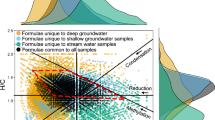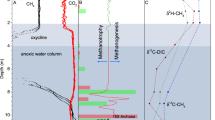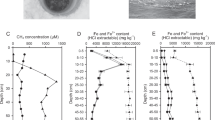Abstract
Methane, a common trace constituent of groundwaters, occasionally makes up more than 20% of the total carbon in groundwaters1,2. In aerobic environments CH4–rich waters can enable microbial food chain supporting a mixed culture of bacteria with methane oxidation as the primary energy source to develop3. Such processes may influence the isotopic composition of the residual methane and because 13C/12C analyses have been used to characterize the genesis of methanes found in different environments, an understanding of the magnitude of such effects is necessary. In addition, carbon dioxide produced by the methane-utilizing bacteria can be added to the inorganic carbon pool of affected groundwaters. We found carbon dioxide experimentally produced by methane-utilizing bacteria to be enriched in 12C by 5.0–29.6‰, relative to the residual methane. Where methane-bearing groundwaters discharged into aerobic environments microbial methane oxidation occurred, with the residual methane becoming progressively enriched in 13C. Various models have been proposed to explain the 13C/12C and 14C content of the dissolved inorganic carbon (DIC) of groundwaters in terms of additions or losses during flow in the subsurface4,5. The knowledge of both stable carbon isotope ratios in various pools and the magnitude of carbon isotope fractionation during various processes allows geochemists to use the 13C/12C ratio of the DIC along with water chemistry to estimate corrected 14C groundwater ages4,5. We show here that a knowledge of the carbon isotope fractionation between CH4 and CO2 during microbial methane-utilization could modify such models for application to groundwaters affected by microbial methane oxidation.
This is a preview of subscription content, access via your institution
Access options
Subscribe to this journal
Receive 51 print issues and online access
$199.00 per year
only $3.90 per issue
Buy this article
- Purchase on Springer Link
- Instant access to full article PDF
Prices may be subject to local taxes which are calculated during checkout
Similar content being viewed by others
References
Dyck, W., Chattejee, A. K., Gemmell, D. E. & Murricane, K. Geochem. Explor. 6, 139–162 (1976).
Barker, J. F. thesis, Univ. Waterloo, Ontario (1979).
Gunsalus, R. P., Zeikus, J. G. & Wolfe, R. S. Res. Rep. No. 57, 38 (University of Illinois Water Resources Center, 1972).
Reardon, E. J. & Fritz, P. J. Hydrol. 36, 201–114 (1978).
Wigley, T. M. L., Plummer, L. N. & Pearson, F. J. Geochim. cosmochim. Acta 42, 1117–1139 (1978).
Silverman, M. P. & Oyama, V. I. Analyt. Chem. 40, 1833–1837 (1968).
Brown, L. R., Strawinski, R. J. & McCleskey, C. S. Can. J. Microbiol. 10, 791–799 (1964).
Galimov, E. K. M. Int. Geol. Rev. 11, 1092–1104 (1969).
Richet, P., Bottinga, Y. & Javoy, M. An. Rev. Earth planet. Sci. 5, 65–110 (1977).
Claypool, G. E. & Kaplan, I. R. in Natural Gases in Marine Sediments (ed. Kaplan, I. R.) 99–150 (Plenum, New York, 1974).
Nissenbaum, A., Presley, B. J. & Kaplan, I. R. Geochim. cosmochim. Acta 36, 1007–1027 (1972).
Lyon, G. L. Init. Rep. DSDP 20, 773–774 (1973).
Dubrova, N. V. & Nesmelova, Z. N. Geochem. Int. 5, 872–876 (1968).
Barker, J. F., Legall, F., Fritz, P. & Barnes, C. R. Ont. Geol. Surv. Misc. Paper 87, 7–10 (1979).
May, F., Freund, W., Muller, E. P. & Dostal, K. P. Angew. Z. Geol. 14, 376–380 (1967).
Coleman, D. D., Meents, W. F., Liu, C. L. & Keough, R. A. Illinois State Geol. Surv. ILL Pet. 111 (1977).
Author information
Authors and Affiliations
Rights and permissions
About this article
Cite this article
Barker, J., Fritz, P. Carbon isotope fractionation during microbial methane oxidation. Nature 293, 289–291 (1981). https://doi.org/10.1038/293289a0
Received:
Accepted:
Issue Date:
DOI: https://doi.org/10.1038/293289a0
This article is cited by
-
Soil depth gradients of organic carbon-13 – A review on drivers and processes
Plant and Soil (2024)
-
Akkumulation von Sulfat und Karbonat in nordostdeutschen Grundwässern – Eine Multi-Isotopen-Analyse
Grundwasser (2023)
-
Differentiation of Carbon Isotope Composition and Stratabound Mechanism of Gas Desorption in Shallow-Buried Low-Rank Multiple Coal Seams: Case Study of Well DE-A, Northeast Inner Mongolia
Natural Resources Research (2021)
-
Seasonal and weather-related controls on methane emissions from the stems of mature trees in a cool-temperate forested wetland
Biogeochemistry (2021)
-
Dissolved carbon, greenhouse gases, and δ13C dynamics in four estuaries across a land use gradient
Aquatic Sciences (2019)
Comments
By submitting a comment you agree to abide by our Terms and Community Guidelines. If you find something abusive or that does not comply with our terms or guidelines please flag it as inappropriate.



